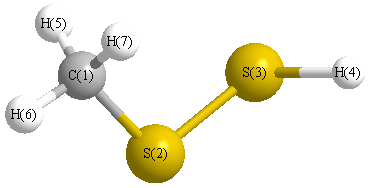Vibrational Frequencies calculated at HF/CEP-121G
| Mode Number |
Symmetry |
Frequency
(cm-1) |
Scaled Frequency
(cm-1) |
IR Intensities
(km mol-1) |
Raman Act
(Å4/u) |
Dep P |
Dep U |
|---|
| 1 |
A |
3330 |
3039 |
15.58 |
56.62 |
0.75 |
0.86 |
| 2 |
A |
3314 |
3024 |
8.12 |
91.56 |
0.74 |
0.85 |
| 3 |
A |
3189 |
2910 |
34.41 |
149.12 |
0.02 |
0.04 |
| 4 |
A |
2687 |
2452 |
17.23 |
232.42 |
0.32 |
0.49 |
| 5 |
A |
1606 |
1465 |
10.59 |
13.50 |
0.69 |
0.82 |
| 6 |
A |
1590 |
1451 |
12.53 |
18.89 |
0.75 |
0.86 |
| 7 |
A |
1496 |
1365 |
11.40 |
0.18 |
0.74 |
0.85 |
| 8 |
A |
1089 |
994 |
11.12 |
6.68 |
0.58 |
0.74 |
| 9 |
A |
1087 |
992 |
3.17 |
8.44 |
0.75 |
0.86 |
| 10 |
A |
889 |
811 |
5.85 |
19.95 |
0.75 |
0.85 |
| 11 |
A |
715 |
652 |
4.77 |
42.20 |
0.38 |
0.55 |
| 12 |
A |
487 |
444 |
1.36 |
81.88 |
0.27 |
0.43 |
| 13 |
A |
254 |
232 |
34.85 |
18.06 |
0.74 |
0.85 |
| 14 |
A |
229 |
209 |
1.20 |
6.49 |
0.63 |
0.77 |
| 15 |
A |
163 |
149 |
1.30 |
0.20 |
0.74 |
0.85 |
Unscaled Zero Point Vibrational Energy (zpe) 11062.0 cm
-1
Scaled (by 0.9125) Zero Point Vibrational Energy (zpe) 10094.0 cm
-1
See section
III.C.1 List or set vibrational scaling factors
to change the scale factors used here.
See section
III.C.2
Calculate a vibrational scaling factor for a given set of molecules
to determine the least squares best scaling factor.
Charges, Dipole, Quadrupole and Polarizability
Charges from optimized geometry at HF/CEP-121G
Charges (e)
| Number |
Element |
Mulliken |
CHELPG |
AIM |
ESP |
| 1 |
C |
-0.622 |
|
|
|
| 2 |
S |
0.068 |
|
|
|
| 3 |
S |
-0.102 |
|
|
|
| 4 |
H |
0.070 |
|
|
|
| 5 |
H |
0.203 |
|
|
|
| 6 |
H |
0.194 |
|
|
|
| 7 |
H |
0.188 |
|
|
|
Electric dipole moments
Electric dipole components in Debye
(What's a Debye? See section
VII.A.3)
| |
x |
y |
z |
Total |
| |
-1.491 |
1.679 |
1.355 |
2.623 |
| CHELPG |
|
|
|
|
| AIM |
|
|
|
|
| ESP |
|
|
|
|
Electric Quadrupole moment
Quadrupole components in D Å
| Primitive |
|---|
| | x | y | z |
|---|
| x |
-30.325 |
-1.196 |
2.773 |
| y |
-1.196 |
-35.038 |
0.599 |
| z |
2.773 |
0.599 |
-32.595 |
|
| Traceless |
|---|
| | x | y | z |
|---|
| x |
3.491 |
-1.196 |
2.773 |
| y |
-1.196 |
-3.578 |
0.599 |
| z |
2.773 |
0.599 |
0.087 |
|
| Polar |
|---|
| 3z2-r2 | 0.174 |
|---|
| x2-y2 | 4.713 |
|---|
| xy | -1.196 |
|---|
| xz | 2.773 |
|---|
| yz | 0.599 |
|---|
|
Polarizabilities
Components of the polarizability tensor.
Units are
Å
3 (Angstrom cubed)
Change units.
| |
x |
y |
z |
| x |
10.476 |
0.802 |
0.278 |
| y |
0.802 |
5.937 |
0.080 |
| z |
0.278 |
0.080 |
4.900 |
<r2> (average value of r
2) Å
2
| <r2> |
73.588 |
| (<r2>)1/2 |
8.578 |
